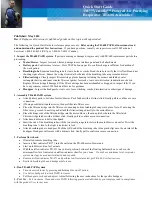
4
CAUTION
19. During installation, before run the compressor, confirm the refrigerant pipes are fixed. Operation of compressor without fixing the piping,
setting the valves at open condition, a burst may occur and cause injury.
20. During pump down operation, stop the compressor before remove the refrigerant piping. (Removal of refrigeration piping while compressor is
operating and valves are opened condition will cause suck-in of air, abnormal high pressure in refrigeration cycle and result in explosion,
injury etc.)
21. After completion of installation or service, confirm there is no leakage or refrigerant gas. It may generate toxic gas when the refrigerant
contacts with fire.
22. Ventilate if there is refrigerant gas leakage during operation. It may cause toxic gas when refrigerant contacts with fire.
23. Do not insert your fingers or other objects into the unit, high speed rotating fan may cause injury.
24. Must not use other parts except original parts describe in catalog and manual.
25. Using of refrigerant other than the specified type may cause product damage, burst and injury etc.
1. Do not install the unit at place where leakage of flammable gas may occur. In case gas leaks and accumulates at surrounding of the
unit, it may cause fire.
2. Carry out drainage piping as mentioned in installation instructions. If drainage is not perfect, water may enter the room and damage
the furniture.
3. Tighten the flare nut with torque wrench according to specified method. If the flare nut is over-tightened, after a long period, the flare
may break and cause refrigerant gas leakage.
4. Do not touch outdoor unit air inlet and aluminium fin. It may cause injury.
5. Select an installation location which is easy for maintenance.
6. Pb free solder has a higher melting point than standard solder; typically the melting point is 50°F – 70°F (30°C – 40°C) higher. Please use
a high temperature solder iron. In case of the soldering iron with temperature control, please set it to 700 ± 20°F (370 ± 10°C).
Pb free solder will tend to splash when heated too high (about 1100°F / 600°C).
7. Power supply connection to the air conditioner. Connect the power supply cord of the air conditioner to the mains using one of the following
methods.
Power supply point shall be the place where there is ease for access for the power disconnection in case of emergency. In some countries,
permanent connection of this room air conditioner to the power supply is prohibited.
i. Power supply connection to the receptacle using a power plug.
Use an approved 15/16A (1.0 ~ 1.75HP) or 16A (2.0HP) or 20A (2.5HP) power plug with earth pin for the connection to the socket.
ii. Power supply connection to a circuit breaker for the permanent connection.
Use an approved 16A (1.0 ~ 2.0HP) or 20A (2.5HP) circuit breaker for the permanent connection. It must be a double pole switch with a
minimum 3.0 mm contact gap.
8. Do not release refrigerant during piping work for installation, servicing, reinstallation and during repairing a refrigerant parts. Take
care of the liquid refrigerant, it may cause frostbite.
9. Installation or servicing work: It may need two people to carry out the installation or servicing work.
10. Do not install this appliance in a laundry room or other location where water may drip from the ceiling, etc.
11. Do not sit or step on the unit, you may fall down accidentally.
12. Do not touch the sharp aluminum fins or edges of metal parts.
If you are required to handle sharp parts during installation or servicing, please wear hand glove.
Sharp parts may cause injury
Summary of Contents for CS-PS9NKV
Page 9: ...9 3 Location of Controls and Components 3 1 Indoor Unit 3 2 Outdoor Unit 3 3 Remote Control...
Page 10: ...10 4 Dimensions 4 1 Indoor Unit 4 1 1 CS PS9NKV CS PS12NKV...
Page 11: ...11 4 1 2 CS PS18NKV CS PS24NKV...
Page 12: ...12 4 2 Outdoor Unit 4 2 1 CU PS9NKV 4 2 2 CU PS12NKV CU PS18NKV...
Page 13: ...13 4 2 3 CU PS24NKV...
Page 14: ...14 5 Refrigeration Cycle Diagram 5 1 CS PS9NKV CU PS9NKV CS PS12NKV CU PS12NKV...
Page 15: ...15 5 2 CS PS18NKV CU PS18NKV CS PS24NKV CU PS24NKV...
Page 16: ...16 6 Block Diagram 6 1 CS PS9NKV CU PS9NKV...
Page 17: ...17 6 2 CS PS12NKV CU PS12NKV...
Page 18: ...18 6 3 CS PS18NKV CU PS18NKV...
Page 19: ...19 6 4 CS PS24NKV CU PS24NKV...
Page 20: ...20 7 Wiring Connection Diagram 7 1 Indoor Unit 7 1 1 CS PS9NKV CS PS12NKV...
Page 21: ...21 7 1 2 CS PS18NKV CS PS24NKV...
Page 26: ...26 8 Electronic Circuit Diagram 8 1 Indoor Unit 8 1 1 CS PS9NKV CS PS12NKV...
Page 27: ...27 8 1 2 CS PS18NKV CS PS24NKV...
Page 28: ...28 8 2 Outdoor Unit 8 2 1 CU PS9NKV...
Page 29: ...29 8 2 2 CU PS12NKV...
Page 30: ...30 8 2 3 CU PS18NKV...
Page 31: ...31 8 2 4 CU PS24NKV...
Page 33: ...33 9 1 1 2 CS PS18NKV CS PS24NKV 9 1 2 Indicator and Receiver Printed Circuit Board...
Page 34: ...34 9 2 Outdoor Unit 9 2 1 Main Printed Circuit Board 9 2 1 1 CU PS9NKV...
Page 35: ...35 9 2 1 2 CU PS12NKV...
Page 36: ...36 9 2 1 3 CU PS18NKV...
Page 37: ...37 9 2 1 4 CU PS24NKV...
Page 38: ...38 9 2 2 Noise Filter Printed Circuit Board 9 2 2 1 CU PS9NKV...
Page 86: ...86 Figure 13 Figure 14 15 2 3 To remove discharge grille Figure 15...
Page 88: ...88 Figure 19 Figure 20...





































